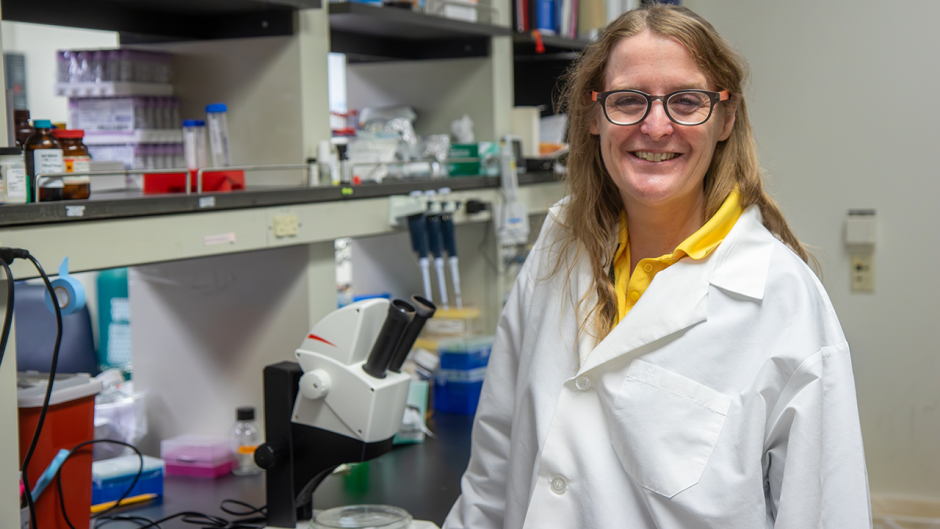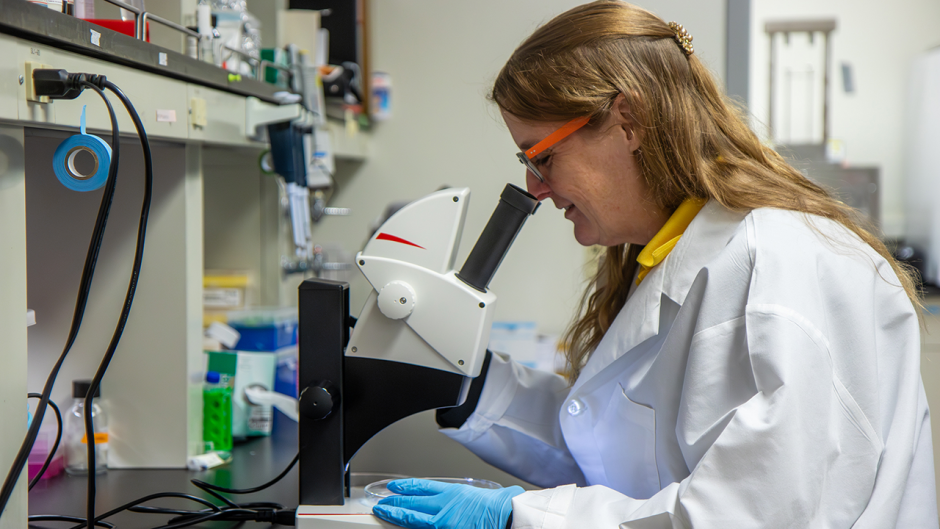Published on
Updated on

Published 11/14/2024
Contact: Brian Consiglio, consigliob@missouri.edu
Photos by Karen Clifford
The plague is one of the deadliest bacterial infections in human history. An estimated 50 million Europeans died from it in the mid-1300s when it was known as the “Black Death.”
Thanks to improved sanitation, public health measures and antibiotics, the Centers for Disease Control and Prevention now reports an average of only seven human cases of plague in the U.S. each year. While humans are largely safe from it, particularly in the eastern half of the U.S., the disease continues to wipe out prairie dog colonies and infect other rodents in the western half of the U.S.
Through the years, scientists have learned more about the role animals — especially rodents — play in the dissemination of the plague, and researchers at the University of Missouri have recently uncovered another alarming way the disease can be passed: from mother flea to offspring.
Deborah Anderson, PhD, a professor in Mizzou’s College of Veterinary Medicine, was the principal investigator on a recent study, which was published in Nature. Read on to learn more about Anderson and why her groundbreaking research is important to animals and humans.

Why did you come to Mizzou?
After the events of September 11, 2001, the federal government provided funding for public universities to invest in bioterrorism defense research — which led to the creation of the building on Mizzou’s campus now known as the Laboratory for Infectious Disease Research (LIDR).
The LIDR is one of only 12 labs in the United States that is classified as Biosecurity Level 3, meaning Mizzou is equipped to safely research diseases that are pathogenic and treatable. As a researcher who studies infectious diseases, there are not many places that can support my research interests like Mizzou can. I knew I had to come here.
Why is it important Mizzou does this type of research?
Resources like LIDR are crucial for driving cutting-edge breakthroughs that protect public health and tackle global challenges. As a leading research university and member of the prestigious Association for American Universities, Mizzou’s top-tier researchers and state-of-the-art facilities are helping us prepare for — and fight against — diseases so we can save lives and improve the health of both animals and humans.
Rodents — especially prairie dogs — are particularly vulnerable to the plague. Entire colonies have been wiped out, impacting the broader ecosystem. In 2009, the plague killed more than 80% of the remaining population of black-footed ferrets — one of the most endangered mammals in the world — who eat prairie dogs as their main food source.
Should people be scared of getting the plague?
No. The Centers for Disease Control and Prevention reports an average of only seven human cases of plague in the United States each year, primarily in the southwestern U.S. The threat to the general public is low, but since there are no plague vaccines licensed for human use, we need to be prepared for any potential threat.
How does this research contribute to the concept of One Health?
This research is a perfect example of how Mizzou prioritizes One Health — the idea that the health of people, animals and the environment are all interconnected. Studying animals can ultimately reduce the chances of humans being exposed to infectious diseases, and the more we learn about how fleas transmit the plague, the more we can help public health officials monitor the health of wildlife ecosystems.
Why is Mizzou uniquely positioned to tackle this type of research?
Our recent study was made possible with an award from the UM System’s Research and Creative Works Strategic Investment Program. The program is part of $260 million in strategic investments the UM System announced in 2018.
This award enabled us to build a multidisciplinary team of vector-borne disease collaborators from the College of Veterinary Medicine; the College of Agriculture, Food and Natural Resources; and the School of Medicine. We are all within walking distance of each other, so we are more likely to have spontaneous discussions, serve on committees together and learn from each other. When it comes to interdisciplinary collaboration, as well as extensive expertise in both basic sciences and vector-borne diseases, Mizzou is among the best.
How is this research conducted safely at Mizzou?
Due to the extensive safety protocols we have in place at the LIDR, I always feel safe when handling bacteria. I am thankful that Mizzou encourages its researchers to see the bigger picture and to tackle challenges that impact society in a safe and secure way.
“Transovarial transmission of Yersinia pestis in its flea vector Xenopsylla cheopis” was published in Nature. Funding was provided by the National Institutes of Health.